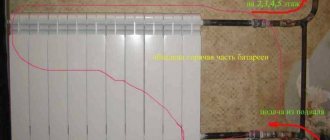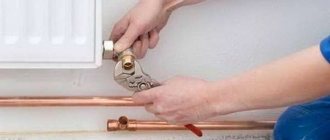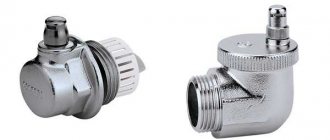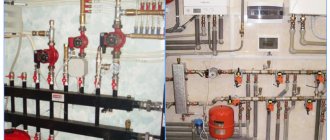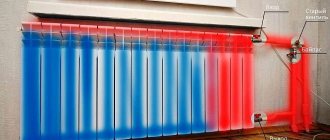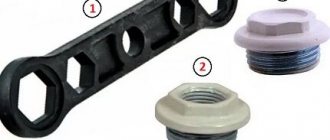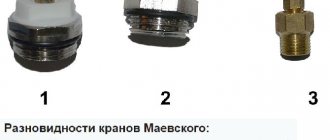Air accumulated in the heating system blocks the flow of coolant. To get rid of air pockets in the heating system, you need to bleed the air from the battery. The deaeration technique depends on the design of the radiators and the features of the system itself.
- How to drain water from cast iron batteries
Heating operating principle
First, you should consider how exactly the heating system works.
It starts with the boiler room, where a boiler is constructed that runs on a specific fuel. It will be responsible for heating the water and its circulation. Pipes are laid from the boiler to the rooms that need to be heated. In urban environments, the length of pipes can reach several kilometers, and they are laid underground so as not to disturb residents. In the rooms, pipes are connected to radiators (radiators), which heat the environment. Previously, radiators were made of cast iron, but now emphasis is placed on aluminum and brass due to their higher reliability: cast iron batteries quickly rusted and became unusable.
Central heating system operation diagram
After connecting the structure, it is filled with special water, which is called “coolant”. Its distinctive feature is that it contains a special alkali that prevents corrosion. This protects the inside of the battery from rust and extends its service life.
Interesting fact: if you fill the battery with ordinary water, it will become unusable within a couple of months.
When the pipes and radiators are completely filled with liquid, the boiler begins to heat it and also circulate in a circle so that stagnation does not form. An increase in the temperature of the coolant causes the battery to heat up and radiate heat, and the room is heated.
Depending on the weather outside, the boiler room regulates the temperature of the boiler, and consequently the temperature of the batteries. This is done by supplying fuel and adjusting operating modes. Previously, coal was most often used as fuel; now preference is given to gas, fuel oil and electricity sources.
Mayevsky manual crane
This is what Mayevsky's crane looks like.
Most modern radiators are equipped with a Mayevsky manual air vent. The device comes in an installation kit, which is included with most modern radiators; less often it is purchased separately from the battery.
This is what a universal installation kit for heating radiators looks like.
The product is made of brass and plastic and includes a needle cone valve that is opened manually. A small diameter hole in the open position releases air and coolant in minimal portions, which makes work safe, excluding burns and flooding of the room.
Mayevsky taps are produced with a connecting thread diameter of 1, ¾ or ½ inches.
A special plastic key in the shape of a butterfly is included for manipulation. It must be handled with care, as with great force it may break. You can open the tap with a flat screwdriver, and there are also varieties for manipulation without additional devices.
Advice! After installing the radiators, keep all keys in a separate place or tie them to the radiator so as not to lose them. It is inconvenient to work in a niche under the window sill; you will need a short non-standard screwdriver, since the battery can take up most of the space.
Mayevsky cranes may differ in appearance, but the principle of operation and operation of most of them are the same.
The most common types of Mayevsky cranes.
Instructions for working with the Mayevsky crane
Before draining the water, it is recommended to tighten and unscrew the radiator shut-off valves or thermostat, if such devices are installed, 1-2 times. If the devices have not been used for a long time, then the reason for cold batteries may be that they are clogged, interfering with the circulation of the coolant.
If no malfunction is detected in the regulator, then proceed to bleed the air in according to the following algorithm:
| Photo | Description |
| Turn the drain nozzle away from the wall so that the stream of water does not spoil the wallpaper (paint). | |
| Using a key (screwdriver, hand), open the tap counterclockwise a quarter or half a turn, depending on the pressure of the outlet air and liquid. | |
| Wait until the air stops escaping and a continuous flow of coolant begins to flow. | |
| Close the tap all the way. After 1–2 minutes, repeat the procedure. |
If after 5–10 minutes the battery warms up evenly, we can assume that the draining operation was successful.
If the coolant does not flow out of the battery at all, then the needle valve in the Mayevsky tap is clogged. Having closed the radiator shut-off valves, you can completely unscrew the regulator and clean the hole with a needle.
Attention! It is dangerous to completely unscrew the valve under pressure in the system without closing the shut-off valves. The coolant pressure will not allow you to screw the valve back in, and the liquid temperature (up to 110 °C) will cause burns.
Scheduled repairs
Do you want to clean your radiator? Exchange for a newer model or, vice versa (because, in your opinion, they are better)?
If you live in a private house, there are no problems. Just don’t forget that it’s better to fill the system right away and make sure that nothing is leaking anywhere.
If you live in an apartment and you have the opportunity to disconnect from the riser and change the battery yourself, do it. If not, it is better for you to contact the organization that services the heating network of your home so that its employees will shut off the heating system and release water from it centrally.
Material on the topic - (detailed step-by-step instructions are provided).
Methods for flushing radiators and new methods for cleaning the internal surface ↑
During operation, the internal surface of the heating system becomes covered with rust, salt deposits, and other impurities. All this complicates the circulation of hot water and significantly reduces the air temperature in the apartment. Regular cleaning of heating radiators removes blockages and restores normal circulation of coolant.
It is possible to clean the heat exchanger, equipped with outlet and inlet taps, even during the period when the central heating is already working, but when the riser is hot, the batteries remain cold. First of all, turn off both taps, then remove the radiator using a suitable wrench and divide it into sections. The next part of the work does not require special skills - each element is washed well under a strong stream of water. If a lot of scale has accumulated inside and the sediment cannot be easily removed, you will have to deal with it using chemicals. After drying, the entire structure is assembled to its original form, and all joints are carefully sealed.
Heavy batteries that cannot be removed are washed on site. To do this, remove one plug, and then pour inside, preferably under pressure, hot water to which a chemical solvent has been added, for example, soda ash. The heating element is left in this state for a couple of hours, then the solution is drained and clean water is poured under pressure. It is advisable to do several rinses, and if necessary, you can repeat the chemical treatment. To enhance the effect, you can lightly tap the compartments before pouring water, this will help the plaque move away from the walls.
Ideally, flushing should be done before the start of the heating season, when utility services have not yet poured water into the system, but have already managed to blow out the risers.
For heat exchangers that are difficult to turn off and wash, there is professional equipment that allows you to precisely remove deposits in any season, including the heating season. The result is achieved through high pressure, compressed air and shock waves. Such equipment allows you to clean not only radiators, but also pipes.
Materials, equipment and procedure for draining water
To perform the necessary work, you will need a compressor, and of good performance, with a receiver for storing compressed air.
As you already understood, a car one is not suitable for these purposes.
If you are planning to drain used antifreeze, then you yourself understand that it is not worth draining it anywhere.
Clamps of the appropriate size for a reliable hose connection will also be needed.
Connect the hose from the compressor to the underfloor heating supply manifold.
The supply manifold may or may not have a special fitting in its design for filling the system under the hose. Therefore, the automatic air vent is unscrewed on the supply comb and a hose is connected through a suitable adapter and tightened with a clamp.
Arrangement of elements on the manifold for draining
- In the same way, connect the hose to the return manifold and lead it to the drainage point.
- Close the supply and return valves coming from the boiler in the manifold area.
- Using flow meters or valves (depending on your collector), close all underfloor heating circuits, except one, which, on the contrary, needs to be opened to the maximum.
- Turn on the compressor, open the valves or tap (depending on the type of comb) that are designed to fill and drain the system (those with hoses on them). At this moment, the coolant will begin to flow out of the drain hose under pressure. Wait until the water runs out and air comes out. At this point, pay attention to the pressure gauge on the compressor. If the pressure in the receiver at this moment is not high (1-3 atm), then close one of the taps on which the hose is attached (preferably, it would be a tap on the supply manifold, or if the pump is equipped with its own shut-off device, it is better to use it) . Wait for the pressure to rise to 5 atm. (no more) and blow out the floor loop under this pressure.
- Close the blown circuit and open the next one. Repeat the same procedure with him.
- In this way, drain the water from all underfloor heating circuits.
- For better efficiency, repeat the procedure after half an hour, since the remaining droplets of water in the pipe can connect with each other and eventually block the cross-section of the pipe in a certain place.
By following this method, you will solve the problem of how to drain water from a heated floor. The only problem is getting a compressor that can handle this task.
Self-pressure testing of underfloor heating systems
First launch of a warm water floor
Rules for installing a heated water floor based on a concrete screed
How to flush a heated floor heating system and how to completely flush the heating system in a private house with your own hands
Installation of water heated floors without concrete screed
Warm water floor system technology
New filling of a closed system
A feature of closed systems is the absence of direct contact with the atmosphere. The air in such systems must be manually released through bleeder valves.
The taps in such a system are located at several points : at the top point of the system above the boiler or on the top floor, in the boiler itself, on the radiators.
When filling, a transparent hose is placed on the top tap, and the coolant is pumped until clean water comes out of the hose.
The tap is closed, air is pumped into the membrane expansion tank to create pressure and the batteries are de-aired.
When a circulation pump , it will successfully drive away the remaining air. If after some time gurgling sounds are heard in the boiler or radiators, it is worth repeating the operations with the taps.
How to protect your system from freezing
In addition to being able to drain the water, the system must be protected - at least partially - from frost. Not only a simple drain of water can save an individual water supply system from freezing - modern materials and technologies are at your service. To protect water shut-off valves from freezing of residual water, use faucets with ceramic parts and taps with rubber seals. The most resistant to water freezing are pipes, as we said above, not made of steel, but of low-density polyethylene (HDPE). Flexible plastic can withstand some increase in the volume of internal ice without collapsing, but it is still safer not to test the water supply for strength and remove all water from the water supply system before the onset of cold weather.
Lay water supply pipes from the well to the residential building along the bottom of a trench dug to a frost-free depth. This guarantees complete protection of the external water supply system from any frost. The pipes must be sloping towards the water source so that the return flow occurs unhindered. Protect pipes that go to the surface - for example, a short section of pipe from a trench into a house - with a heating cable.
Draining water from the water supply system for the winter will not be difficult if this function is initially included in the design of the external and internal water supply. A technically competent solution to this problem is only possible if the design and installation of pipes for individual water supply are entrusted to professionals.
Category: Water supply and heating
How to bleed air from old-style batteries
To this day, in the housing stock of Russia there are houses built a long time ago with batteries of the MS-140 model. In those days when these batteries were installed, they were equipped with ordinary water taps or simple bolts embedded in plugs with seals to bleed air.
The plugs are reset by simply opening these devices until a continuous stream of water appears without bubbles. If both devices are missing, remove the plugs by unscrewing the plugs, as described above.
Emergency situation
By emergency we mean a case where the battery leaks. Again, if there is a tap that turns off the battery, turn it off and drain it; if not, you cannot do without calling a plumber.
The battery does not heat up
Cold water in the radiator, although the heating has been turned on a long time ago? Means, . In theory, your radiators should be equipped with a Mayevsky tap. If your battery is installed correctly (the angle in which the valve is installed should be slightly higher), then when you open the valve to bleed off excess air, only air will come out; as soon as the water starts flowing (don’t forget to immediately replace the jar), it means that the air has escaped and there is no more plug. If the radiator is installed completely horizontally, you may have to drain more water.
The rifar radiator has special drain taps
The Mayevsky crane is not installed? Perhaps it is better in this case to turn to specialists. Why?
Equipment tends to break down over time. Imagine that you managed to cope with coking and drain the water. But closing them is no longer possible.
Can you imagine what consequences this will lead to?
- Firstly, you will flood your neighbors, and you will still have to call a locksmith to turn off the heating in the entire house.
- Secondly, you will leave the entire house (or at least the entrance) without heating for quite a long time - until the consequences of your “amateur activity” are eliminated.
- In addition, if heating in your home is provided by an individual boiler, then the contract you concluded with the service organization states that it is prohibited to drain the water yourself. This is due to the loss of the required pressure level, which is signaled by special emergency sensors.
Types of air vents
Air exhaust devices can be manual or automatic.
The manual air vent is called the “Mayevsky tap”, is oversized and is usually installed at the end of the battery. This device has a side hole through which air comes out, and then water, so when installing the Mayevsky tap, you should pay attention so that this hole looks exactly down and not into the wall. Adjustment is made with a special key, but a simple screwdriver will do. This type of valve is suitable for releasing a small amount of air in one battery.
The automatic air vent does not require human assistance. Such devices are quite productive, but at the same time they are sensitive to water quality, so they are installed together with filters. Such air vents can be installed both vertically and horizontally, preferably at each node of the heating system.
Operating principle of the device:
- The air outlet valve is tightly closed with a float.
- When air accumulates in the radiator, the float rises and opens the valve, releasing the air.
- When it comes out, the float returns to its original position, closing the valve.
How to properly drain water from the system
If a summer water supply system was installed on the site and the water rose from a shallow well or well, then in addition to draining the water from the internal distribution system in the house, it is necessary to remove the pump so that the water in the water supply pipe does not freeze. Such simple systems usually do not provide any specialized means for convenient draining. If water is supplied to the house from a well with a caisson, then there is no need to lift the pump from the well - just open the drain valve above the head and the water from the water supply system will return to the well. The drain valve is located between the check valve and the accumulator. During the process of draining water, all taps at water collection points must be open. If there is a storage tank in the house, drain the water from it. Don’t forget about the summer water supply located outside - it will suffer from frost before anyone else.
To carry out effective drainage, water pipes must have a certain slope so that all the water is guaranteed to leave the system and not linger somewhere inside. A small amount of water remaining in the pipe and turning into ice can rupture the pipe and break the seal. Even a strong steel pipe will not be able to withstand the pressure of the ice that forms. Water from the water heater is also drained through a drain valve connected to the tee. The tap and tee must have a hose attachment to the check valve on the incoming water heating pipe. Another tee with a tap must be installed on the outlet pipe from the heater to supply air when draining water.
If for some reason the drain taps were not installed when installing the water supply system, and frost is about to hit, then you can remove water from the pipes using a compressor. Getting into the pipes through the tee, compressed air is able to displace all the water out. The compressor can be used even with a drain valve if you want to purge the system and make sure that there is not a drop of water left in it. Air blowing is especially important if the internal water supply in the house is made of hard plastic pipes, which, for the sake of design, are mounted strictly horizontally. In this case, complete drainage from the system is obviously not guaranteed and the use of purging is mandatory.
If you live in a country house permanently, and the heating system uses ordinary water rather than antifreeze, then before leaving for a long time in winter, it will also have to be drained so that the heating pipes and radiators do not fail. Of course, for such cases, various complexity and price options have been developed for emergency heating of the water supply system, heating system, or the room as a whole to a temperature of several degrees above 0 C. But all these methods do not guarantee complete protection, because the boiler or other heat source is mainly controlled using electronics, and in your absence the electricity may be turned off. In addition, electric heating equipment constantly turned on in the absence of owners increases the risk of fire. Therefore, the best, cheapest and most reliable protection of the heating system from freezing is the use of antifreeze.
But if it happens that instead of antifreeze, water is used as a coolant, then how to properly drain this water from the heating system? Turn off the boiler or close the distribution valve on the pipe leading from the riser. Close the valve through which water is supplied to the heating system. To drain water from the radiator system, use a hose of the required length to divert the water to a discharge point into the sewer or into the street. Open the drain valve on the radiator, and in the heating system, open the faucet with the air valve - this will speed up the drainage of water.
Where else can water remain? Don't forget to drain the water from all siphons (hydraulic seals). There are water seals in every home; they are located in curved sections of the drain pipe under sinks, under bathtubs, and in toilets. Water also remains in the coarse filter, in the main filter unit, in the washing machine and dishwasher and in the electric water heater. Simply put, before closing your dacha for the winter season, check all the devices to which water was supplied in the summer.
All work on draining water and preserving the individual water supply system must be carried out at a temperature not lower than + 5 C.
How to understand that the battery is airy
Signs of a possible air lock:
- The room becomes cold. The “damaged” radiator is cooler to the touch than the others and there are cold spots on it. If you knock on a cool place, a ringing sound will be heard. Liquid-filled areas sound duller.
- When you lean your ear, you can hear hissing, noise, gurgling. Sometimes these sounds are quite loud.
- With minor gas accumulations, heating does not decrease and it is difficult to determine the presence of a plug. But the accumulated gases are doing their job. Because of them, radiators and pipes leak, circulation pumps “fly” to pump coolant.
If something similar happens in the house, it means you need to get the air out urgently. Otherwise, the rooms will be cold, and system elements will have to be constantly replaced or repaired.
Replacing a radiator in an apartment building
If you only need to change the radiator for repairs, then every apartment owner must know how to properly shut off the radiator.
If the system in the house was installed in good faith, then this possibility certainly exists. By closing the shut-off valves at the battery inlet, which stops the supply of water to the radiator, but does not stop the circulation of water in the heating system, you can begin to replace the battery. Further actions depend on the presence of an outlet valve. If there is one, then the water is drained through the tap, but more often it is not, so the drain is performed when the inlet or outlet pipe is disconnected. You should place a container for water so as not to flood your neighbors.
Knowing how to shut off a heating battery is also necessary to prevent various emergencies, such as a severe leak due to the destruction of the radiator. Every owner needs to know the phone number of the organization where to contact about heating immediately in the event of an emergency.
If a single-pipe heating scheme is used, then a bypass must be installed. Every apartment owner should have a clear and precise understanding of how to shut off the heating radiator in this case.
With such a circuit diagram, the following actions are carried out:
- the bypass valve opens completely;
- close the shut-off valves on the battery on both sides.
Having completed these operations, you can begin to remove the radiator from the system.
After replacing the battery, sealing the connections and tightening the locknuts, gradually open the valves at the battery inlet and outlet.
At the same time, the Mayevsky tap opens and the bypass closes. Slowly filling the battery prevents water hammer, and the air from the battery is released through the Mayevsky tap until water appears. This will mean that the battery is filled with liquid, the air has been removed, and the shut-off valves on the battery can be opened completely.
How to avoid air jams
The easiest way to avoid air locks is with autonomous heating. The main thing is to install everything correctly:
- Place an air vent near the boiler and on the collectors, through which the bulk of the resulting gas-air mixture will escape.
- Install a separator behind the boiler to remove small air bubbles. The water flow in the separator is slowed down, the bubbles become larger and are removed through a special outlet.
- Install automatic Mayevsky valves on each radiator, through which gases escape to the outside.
If an autonomous type heating system is equipped in this way, there will be no airing in it.
In a direct-flow system, traffic jams can be avoided if the inclination of the elements is set correctly. Then the gas-air mixture will escape through the expansion tank.
In other cases, air will accumulate in the batteries. Its formation can be reduced if you monitor the tightness, carry out installations correctly, fill only the appropriate coolant and control its temperature. It would not hurt to install automatic valves to constantly remove gases from the system.
A drastic measure is to replace the heating batteries ↑
Unfortunately, old radiators that have been heating your home for decades can no longer be brought back to life by flushing. If, even after general internal cleaning, the batteries remain cold when the riser heats up, they will have to be mercilessly replaced with new ones. Radiators made of stainless steel or chrome-plated are ideal for the bathroom. When purchasing a painted radiator, you should take into account the quality of paint application - in conditions of high humidity it must be impeccable.
Aluminum heat exchangers have low operating pressure, so they are not recommended for installation in apartments located above the 8th floor. In addition to this drawback, they have another significant drawback - the inner surface of these products is susceptible to corrosion, so you should not expect long years of service from them.
Radiators with towel hangers are produced especially for bathrooms. They not only perform their main function, but also allow you to neatly hang towels for quick drying. To decorate your bathroom, you can choose unusual radiators, which are now easy to find.
Replacing radiators is a complex and time-consuming process that is best left to professionals. Naturally, major repairs should be planned for the season when the heating in the house is turned off.
It is recommended to install chrome surfaces away from possible splashes, otherwise they will constantly become covered with unsightly stains.
How to de-air aluminum, bimetallic and cast iron batteries
Depending on the material of the radiator, the gas removal procedure may differ:
- Aluminum batteries are famous for their low cost and high thermal conductivity. However, aluminum is not a very good option for making a heating device, because... it is capable of reacting with surrounding substances. As a result, this leads to the release of hydrogen. If airiness occurs in the aluminum battery, the problem is solved by using a Mayevsky crane. To remove hydrogen outside, a special film is used as an internal coating. Unfortunately, it has a limited validity period.
- Bimetallic batteries take a different approach: the internal surfaces of devices in direct contact with water are made of water-resistant metal. Aluminum is used to make the ribs. When using thermostats, this allows the system to be pumped and gas released.
- As a rule, a Mayevsky tap or an automatic air vent helps to bleed air from a cast iron battery.
Places of formation and elimination
It is necessary to bleed air from the battery if there is no doubt about its presence. Gasping is indicated by unexpected gurgling sounds. In addition, the owner begins to notice that the heating is uneven. To restore radiator circulation, air must be removed.
If the system is completely aired, first determine where the plugs are forming by tapping the pipes with a hammer. The sound is stronger and more sonorous in the places where the traffic jam occurs; the areas will also have a lower temperature. Having found a place with air, you need to do the following:
- Prepare a key or screwdriver, as well as a basin for water. The thermostat is opened to the maximum level, then the container is placed.
- Open the valve, making sure that all the water from the inside will flow into the substituted container. You can additionally place rags around.
- The valve must be kept open until all the liquid has drained. A slight hiss indicates air escaping. This means that the manipulations are performed correctly.
- If after the procedure the pipes still do not heat up well, then they need to be blown out and washed - the accumulation of rust inside can also cause air to appear.
In addition to mechanical air removal, there is automatic air removal.
If such manipulations do not improve the situation, then check the filling level of the system. Often, plugs occur in the bending area of pipes, so during installation, their dimensions and direction are usually observed. If in some place the slope differs from the planned project, additional drain valves must be installed.
More often, plugs appear in aluminum radiators, since this material is not of particular quality. Aluminum reacts with the coolant, the result is the formation of gases that must be constantly removed from the system. Here it is usually advised to replace aluminum options with higher quality ones with an anti-corrosion coating, and also not to forget about air vents.
Little things and nuances
If, when installing the heating system, the craftsmen were lazy and did not install a special valve on the heating radiator, then you yourself will have to carry out the simple procedure of bleeding air from the battery, but in a slightly different way.
To do this, you need to have a gas or adjustable wrench with you, with which you begin to very slowly unscrew the plug. If the screw cap on a cast iron battery does not come off, apply thread lubricant directly to the thread itself and try again after a certain time.
Appearance of the Mayevsky crane
Next, proceed in the same way as with a regular tap. When screwing the plug into place, do not forget to wrap flax or FUM tape around the thread.
In private houses with an autonomous heating system, it is sometimes necessary to drain the water using an expansion tank, which is always located at the highest point of the heating system.
After the water has been drained, wait a while and then unscrew the tap on the expansion tank. Almost always the plug comes out on its own when the radiator temperature rises. If these actions do not lead to the desired result, bring the water in the heating system to a boil and then the air lock will definitely come out.
Also keep in mind that an air lock can form in places where the pipeline is bent; for this reason, when installing a heating system, it is necessary to maintain the optimal distance for the direction of slopes when laying out the pipeline.
If the actual slope of the pipe differs from the designed one or the pipeline makes a loop, then it is necessary to install additional air bleed valves.
Modern manufacturers of heating radiators are sometimes not very conscientious in their production, and as a result, we receive a low-quality radiator, which can bring additional headaches. And all because, no matter how much you bleed the air from a battery that is not made according to standards, the air in it will be endless. Because the radiator material itself promotes the formation of gases. There is only one solution to this problem - buy a new high-quality battery.
If you prefer the video instruction format, watch the video below. Everything is shown there step by step.
https://youtube.com/watch?v=NMl6uL9AFP8
If you are afraid to do this work yourself, we recommend turning to professionals. Write in the form at the bottom right of this page and the specialist will calculate the cost of the work and advise you on important nuances.
We hope that the material was useful to you. Please click on the social media buttons below.
I wish you a warm home and no air-filled radiators!


